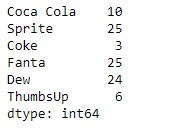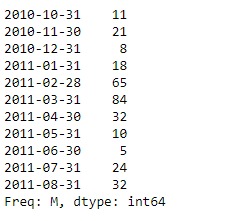Pandas 系列是带有轴标签的一维ndarray。标签不必是唯一的,但必须是可哈希的类型。该对象同时支持基于整数和基于标签的索引,并提供了许多方法来执行涉及索引的操作。
Pandas Series.idxmin()函数返回最小值的行标签。如果多个值等于最小值,则返回具有该值的第一行标签。
用法: Series.idxmin(axis=0, skipna=True, *args, **kwargs)
参数:
skipna:排除NA /空值。如果整个系列为NA,则结果为NA。
axis:为了与DataFrame.idxmin兼容。冗余适用于系列。
返回:idxmin:最小值的索引。
范例1:采用Series.idxmin()函数查找与给定系列对象中的最小值对应的索引标签。
# importing pandas as pd
import pandas as pd
# Creating the Series
sr = pd.Series([10, 25, 3, 25, 24, 6])
# Create the Index
index_ = ['Coca Cola', 'Sprite', 'Coke', 'Fanta', 'Dew', 'ThumbsUp']
# set the index
sr.index = index_
# Print the series
print(sr)输出:

现在我们将使用Series.idxmin()函数查找与该系列中的最小值对应的索引标签。
# return index label of the
# minimum value in the series
result = sr.idxmin()
# Print the result
print(result)输出:

正如我们在输出中看到的,Series.idxmin()函数已返回给定系列对象中最小元素的索引标签。
范例2:采用Series.idxmin()函数查找与给定系列对象中的最小值对应的索引标签。
# importing pandas as pd
import pandas as pd
# Creating the Series
sr = pd.Series([11, 21, 8, 18, 65, 84, 32, 10, 5, 24, 32])
# Create the Index
index_ = pd.date_range('2010-10-09', periods = 11, freq ='M')
# set the index
sr.index = index_
# Print the series
print(sr)输出:

现在我们将使用Series.idxmin()函数查找与该系列中的最小值对应的索引标签。
# return index label of the
# minimum value in the series
result = sr.idxmin()
# Print the result
print(result)输出:

正如我们在输出中看到的,Series.idxmin()函数已返回给定系列对象中最小元素的索引标签。
相关用法
- Python pandas.map()用法及代码示例
- Python Pandas Timestamp.tz用法及代码示例
- Python Pandas Series.str.contains()用法及代码示例
- Python Pandas dataframe.std()用法及代码示例
- Python Pandas Timestamp.dst用法及代码示例
- Python Pandas dataframe.sem()用法及代码示例
- Python Pandas DataFrame.ix[ ]用法及代码示例
- Python Pandas.Categorical()用法及代码示例
- Python Pandas.apply()用法及代码示例
- Python Pandas TimedeltaIndex.contains用法及代码示例
- Python Pandas Timestamp.now用法及代码示例
- Python Pandas Series.str.pad()用法及代码示例
- Python Pandas Series.take()用法及代码示例
- Python Pandas dataframe.all()用法及代码示例
- Python Pandas series.str.get()用法及代码示例
注:本文由纯净天空筛选整理自Shubham__Ranjan大神的英文原创作品 Python | Pandas Series.idxmin()。非经特殊声明,原始代码版权归原作者所有,本译文未经允许或授权,请勿转载或复制。
